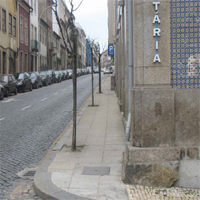Pedestrian Planning in City Centers: a Study of Guimarães and Braga
Abstract
People are walking in cities for different reasons. Some walkers walk for going to work, some are walking for shopping and some are for leisure during day and night hours. Medium sized cities like Braga and Guimarães in Portugal are depending on car for even shorter trips up to 2 kilometers. However, the walkways are allowing people to walk in convenient and safe way including late night environment. The pedestrians feel troublesome to walk on the footpaths because of illegal parking and discontinuation of walkways. Municipality transport plans and master plans do not incorporate pedestrians as a major component. But this egress mode of transportation is very important in medium sized city centers like Guimarães and Braga for the people to enjoy city centers’ activities. This paper focuses on the types of walkers who use the walkways on a regular basis. Usually, people are feeling comfortable to walk when they go to clubs and bars in a group in these small cities especially after work. This paper again tries to focus the varieties of problems on walkways and to present policies that can improve the situation. Municipal master plan and transportation plan have been studied carefully to see the provisions of pedestrian planning options. Field surveys have been conducted both in form of questionnaire and observation during the end of 2009 and results show different patterns of pedestrian behavior as well as evidence that people get different experiences with problems while walking on the walkways in both surveyed towns. Considering the issues of sustainable mobility, this paper also tries to suggest policies to motivate more people to walk especially in the medium-sized cities of Portugal.Downloads
References
Active Access (2010) “Report with Lessons Learnt from Best Practice Studies and Adaptation to Local Context of Walking and Cycling”, Intelligent Energy Europe, Hungary, UK, Germany
Carlos J., Balsas L. (2007) “City Center Revitalization in Portugal: A Study of Lisbon and Porto” Journal of Urban Design, v. 12.
Dargay J. (2005) “The Dynamics of Car Ownership in EU Countries: A Comparison Based on the European Household Panel Survey” Working Paper No. 1010, Transport Studies Unit, Oxford University Center for the Environment, the UK. p. 3.
Florida Department of Transportation (1997) “Florida Pedestrian Planning and Design Handbook” University of North Carolina, Highway Safety Research Center, USA
Jennifer E. (2006) “Sidewalk Planning and Policies in Small Cities”, Journal of Urban Planning and Development, ASCE, Vol. 132 (2)
Mordechay H. David O. Mark T. (2005) “So go down town: simulating pedestrian movement in town centres”, Center for Spatial Analysis, University College London, the UK.
Nelson A.C. (1995) “Private Provision of Public Pedestrian and Bicycle Access Ways: Public Policy Rationale and the Nature of Public and Private Benefits”, TRR 1502.
Pikora T., Corti B., Bull F., Jamrozik K., Donovan R. (2003) “Developing a Framework for Assessment of the Environmental Determinants of Walking and Cycling”, Journal of Social Science and Medicine, Vol. 56.
Portland Pedestrian Master Plan (1998) “City of Portland, Department of Transportation”, USA, p. 1.
Rahaman K., Ohmori N., Harata N. (2006) “Evaluation of the Road side Walking Environment in Dhaka City”, East Asian Studies of Transport Research, pp. 1751 – 1760.
Seattle Pedestrian Master Plan (2007) “Seattle Pedestrian Master Plan 2007”, Department of Transport, Seattle Municipality, USA
Zacharias J. (2001) “Pedestrian Behaviour and Perception in Walking Environments,” Journal of Planning Literature, Vol. 16 (1)

Copyright (c) 2014 Tema. Journal of Land Use, Mobility and Environment

This work is licensed under a Creative Commons Attribution 4.0 International License.
Authors who publish in this journal agree to the following:
1. Authors retain the rights to their work and give in to the journal the right of first publication of the work simultaneously licensed under a Creative Commons License - Attribution that allows others to share the work indicating the authorship and the initial publication in this journal.
2. Authors can adhere to other agreements of non-exclusive license for the distribution of the published version of the work (ex. To deposit it in an institutional repository or to publish it in a monography), provided to indicate that the document was first published in this journal.
3. Authors can distribute their work online (ex. In institutional repositories or in their website) prior to and during the submission process, as it can lead to productive exchanges and it can increase the quotations of the published work (See The Effect of Open Access)
